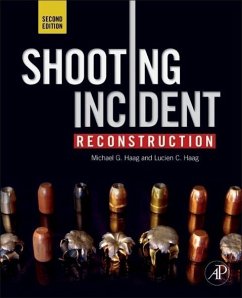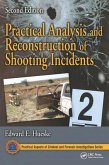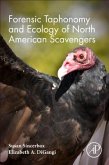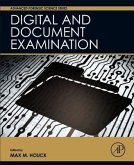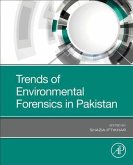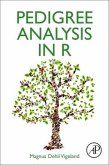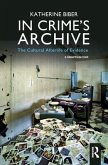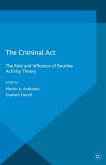Shooting Incident Reconstruction, Second Edition, offers a thorough explanation of matters from simple to complex to help the reader understand the factors surrounding ballistics, trajectory, and shooting scenes.
Forensic scientists, law enforcement, and crime scene investigators are often tasked with reconstruction of events based on crime scene evidence, along with the subsequent analysis of that evidence. The use and misuse of firearms to perpetrate crimes from theft to murder necessitates numerous invitations to reconstruct shooting incidents. The discharge of firearms and the behavior of projectiles create many forms of physical evidence that, through proper testing and interpretation by a skilled forensic scientist, can establish what did and what did not occur.
Written by the world's most well-respected shooting scene and ballistics experts, the book addresses the terminology, science, and factors involved in reconstructing shooting incident events to solve forensic cases. It covers the full range of related topics including: the range from which a firearm was discharged; the sequence of shots in a multiple discharge shooting incident; the position of a firearm at the moment of discharge; and the position of a victim at the moment of impact. The probable flight path of a projectile and the manner in which a firearm was discharged are also discussed. Case studies illustrate real-world application of technical concepts, supported by over 200 full-color diagrams and photographs.
This book will be of value to practicing forensic scientists (firearm and toolmark examiners), ballistics experts, crime scene personnel, police departments, forensic consultants (generalists), attorneys and judges, medical examiners (coroners), and forensic pathologists.
Forensic scientists, law enforcement, and crime scene investigators are often tasked with reconstruction of events based on crime scene evidence, along with the subsequent analysis of that evidence. The use and misuse of firearms to perpetrate crimes from theft to murder necessitates numerous invitations to reconstruct shooting incidents. The discharge of firearms and the behavior of projectiles create many forms of physical evidence that, through proper testing and interpretation by a skilled forensic scientist, can establish what did and what did not occur.
Written by the world's most well-respected shooting scene and ballistics experts, the book addresses the terminology, science, and factors involved in reconstructing shooting incident events to solve forensic cases. It covers the full range of related topics including: the range from which a firearm was discharged; the sequence of shots in a multiple discharge shooting incident; the position of a firearm at the moment of discharge; and the position of a victim at the moment of impact. The probable flight path of a projectile and the manner in which a firearm was discharged are also discussed. Case studies illustrate real-world application of technical concepts, supported by over 200 full-color diagrams and photographs.
This book will be of value to practicing forensic scientists (firearm and toolmark examiners), ballistics experts, crime scene personnel, police departments, forensic consultants (generalists), attorneys and judges, medical examiners (coroners), and forensic pathologists.
"Well illustrated with diagrams and photographs, the book will give police oversight practitioners a better understanding of what crime scene investigators and criminalists can (and perhaps should) do in an officer involved shooting investigation.. The chapter on bullet track determinations in gunshot victims is an excellent primer for a layperson reviewing an autopsy report.. The chapter on shooting of vehicles will be particularly useful for agencies investigating or reviewing such incidents." --National Association for Civilian Oversight of Law Enforcement (NACOLE) Review
Praise for the first edition: "Shooting Incident Reconstruction is an informative and comprehensive guide to the analysis of firearms at crime scenes ranging from accidental injuries to carefully planned murders . . . This book covers it all. No longer will investigators be forced to rely on eyewitness accounts alone; instead, they will be able to use the reconstructive aspects of firearms evidence to determine what did and did not happen at a crime scene." --Law Enforcement Technology"In creating this book, author Lucien C. Haag drew from years of experience in the field, first as a criminalist and later as the former technical director of Phoenix, Ariz., Police Department's forensic laboratory. Shooting Incident Reconstruction provides an explanation of the factors surrounding ballistics, trajectory, and shooting scenes for both the layman and the professional. Key concepts are supported and illustrated by more than 100 diagrams and photographs, many of which are in color. Gun enthusiasts will find much of this book of interest..." --American Rifleman
Praise for the first edition: "Shooting Incident Reconstruction is an informative and comprehensive guide to the analysis of firearms at crime scenes ranging from accidental injuries to carefully planned murders . . . This book covers it all. No longer will investigators be forced to rely on eyewitness accounts alone; instead, they will be able to use the reconstructive aspects of firearms evidence to determine what did and did not happen at a crime scene." --Law Enforcement Technology"In creating this book, author Lucien C. Haag drew from years of experience in the field, first as a criminalist and later as the former technical director of Phoenix, Ariz., Police Department's forensic laboratory. Shooting Incident Reconstruction provides an explanation of the factors surrounding ballistics, trajectory, and shooting scenes for both the layman and the professional. Key concepts are supported and illustrated by more than 100 diagrams and photographs, many of which are in color. Gun enthusiasts will find much of this book of interest..." --American Rifleman

